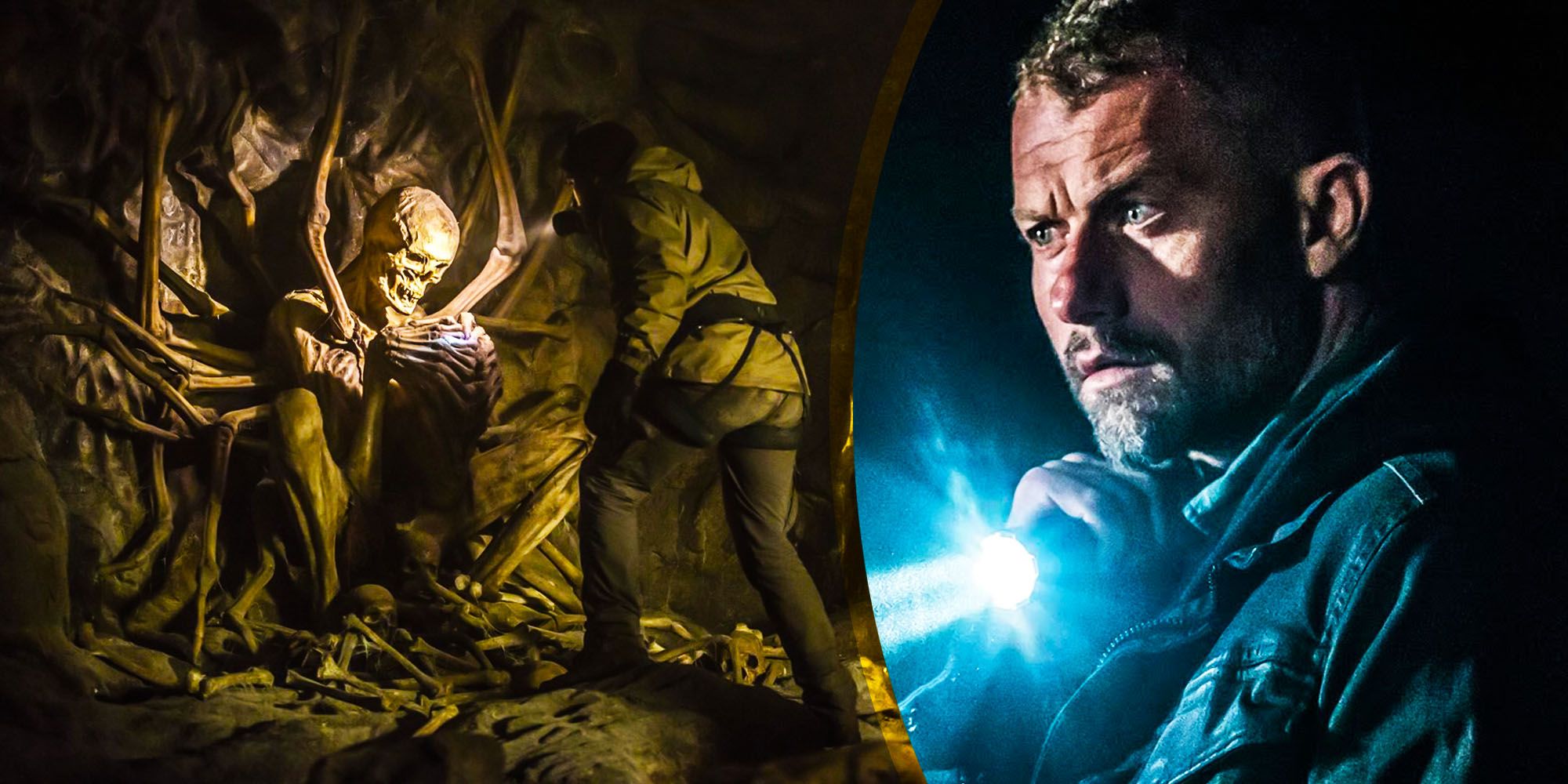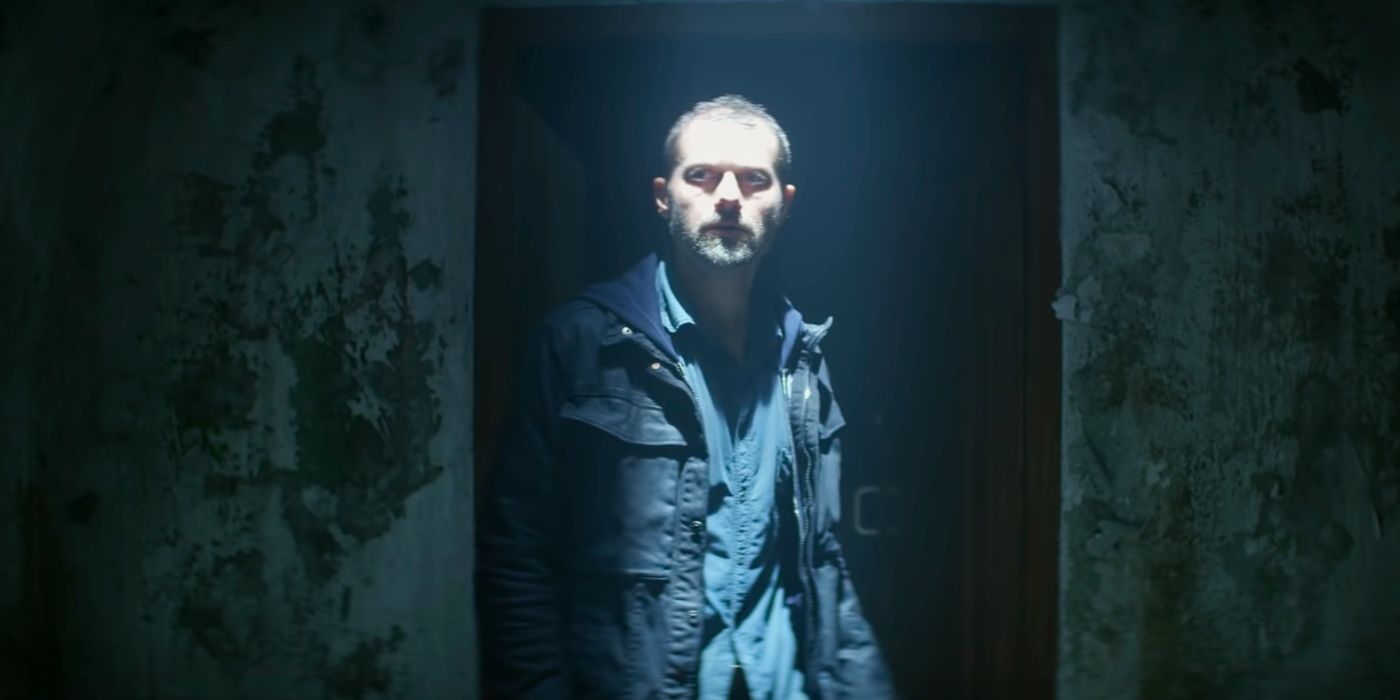The 2020 horror may have a hard-to-decipher twist ending, but with The Empty Man explained the deeper layers of its ambiguous finale, vague plot, and the real Tulpa meaning all become clear. The Empty Man was originally shot in 2017 but shelved for a few years when distributor 20th Century Studios was worried the adaptation of Cullen Bunn’s 2014 graphic novel would potentially confuse audiences. Sure enough, when The Empty Man did arrive in October 2020 most reviewers dismissed the intriguing psychological horror as a convoluted yet paradoxically over-familiar facsimile of The Bye Bye Man, Slender Man, and numerous (supposedly) similar genre efforts.
However, The Empty Man became a cult hit, especially when it arrived on Hulu. In David Prior’s subversive horror movie, a group of friends goes hiking, whereupon one of them stumbles (quite literally) across a bizarre, misshapen skeleton in a cave. Soon after, all the group’s members kill one another thanks to some mind-control trickery, leaving only one survivor, Paul. Fast-forward over twenty years and a troubled former detective, James, is hot on the trail of a missing girl, though he’s haunted by a long-limbed being from his dreams. The ending to this tale was a little ambiguous, but when explained shows how deep The Empty Man truly is.
What Happens In The Empty Man’s Ending
James Becomes The Host For The Empty Man
In the ending of The Empty Man, the protagonist James Lasombra (James Badge Dale), discovers that the cult he has been investigating is far more insidious and influential than he imagined. After following a series of cryptic clues and witnessing several supernatural occurrences, James finds out that he is a “tulpa,” a construct of the collective imagination of the cult and a vessel for the Empty Man. The cult believes that this entity, the Empty Man, can possess individuals and that James is the latest the cult has created for this purpose.
As James delves deeper, it becomes apparent that the cult has manipulated him from the beginning. His interactions, the people he has met, and the supposed coincidences he has encountered were all orchestrated, making him a suitable host for the Empty Man. In a disturbing twist, the cult’s leader explains that the Empty Man requires a human “tulpa,” or thought form, to manifest, and that James must fulfill this role.
The Empty Man concludes with a chilling sequence where James becomes fully assimilated as the Empty Man and accepts his fate. The final scene shows shim being worshipped by the cult members disguised as hospital workers, with the implication that the Empty Man has taken complete control of his being. This ending leaves viewers questioning the nature of the entity and the fates of the characters involved, blurring the lines between reality and the supernatural and suggesting a cycle of horror that could perpetuate endlessly through the cult’s machinations.
The Empty Man’s Cult & Their Goals
Why Did The Cult Choose James?
Having The Empty Man explained largely starts with the movie’s cult, The Pontifex Institute. Their plan is strange and existentially loaded enough that most viewers may have trouble deciphering their intentions on first viewing. Essentially, the group is devoted to bringing an urban legend, the Empty Man, to life. Until now, they have been able to use Paul as a vessel ever since the unfortunate hiker accidentally found the Empty Man’s body back in the ‘90s. However, Paul is dying after years of existing as little more than a host for the monster, meaning the cult needs to make a new conduit for the Empty Man — and quickly.
Aware that any new vessel would be just as mortal (and therefore temporary) as poor Paul, The Pontifex Institute started to research tulpas as an alternative, self-renewing way of bringing the Empty Man to life. The cult members do offer all this information to James when he investigates them, but the question of how this works remains a mystery to him. That is because James has no idea what a tulpa is, and even less of a clue that he is one himself.
The Empty Man’s Tulpa Meaning Explained
What Are Tulpas In The Empty Man?
As if to reaffirm the movie’s cult potential and just how legitimately strange the story is, The Empty Man’s tulpas have not been seen in much popular fiction outside the third season of Twin Peaks. Twin Peaks tweaked the tulpa concept a little by having them engineered in a lab, but tulpas crop up in many movies and stories. The Empty Man follows the more traditional tulpa route and explains that tulpas are a shared idea that is believed in by so many, and with such immense intensity, that it transcends imagination and becomes a flesh-and-blood reality. In layman’s terms, if enough people believe a tulpa is real, it will be.
The Empty Man himself is an example of this phenomenon. If The Pontifex Institute manages to generate enough belief in the tulpa, it will become physically real, able to influence the world, and can then sustain itself. A comparable cultural institution that may help horror fans make sense of the premise is Freddy Krueger or Candyman, both of whom derived their power from people believing in them. A more recent example of a tulpa is Mr. Babadook, the monster from The Babadook, who is a manifestation of an idea from a kids’ book that gets believed in so strongly that it becomes real.
However, while viewers aren’t unfamiliar with the concept of a tulpa being a villain as outlined above, The Empty Man goes a step further. The twist ending reveals that its hero, James, is also a tulpa. In The Empty Man,The Pontifex Institute created a tulpa in the form of James to be the new host of the Empty Man, with the 2020 movie’s bleak ending showing them devoting all their mental power to creating a tragic but believable backstory that ensured James would accept his role as the monster’s human form. This is much more in line with Twin Peaks’ use of tulpas, many of whom also have no idea that they’re not human.
The Empty’s Man Ending Explained
What The Last Scenes In The Empty Man Mean
James finally finds Amanda in a hospital, only to discover she faked her disappearance as part of the Pontifex Institute’s grand plan. She notes the Empty Man has invaded James’ thoughts, describing his presence as an “itch on the brain,” and tells him to accept his fate. This fate, Amanda reveals, is for James to replace Paul as the Empty Man’s vessel. The villain reveals that James exists as a tulpa, a figment of the collective imagination of the cult. While this seems reminiscent of Bruce Willis being dead in The Sixth Sense, the twist of James in The Empty Man being not-quite-human isn’t obvious upon rewatching.
However, viewers have seen James interact with all manner of people and watched him sit at home alone in plenty of scenes while thinking back on his tragic life. Whether these moments were real or not isn’t as clear-cut. When Amanda reveals the truth to James, he calls her mother Nora who hired him — and although she is a real person, she’s never heard of James. He is then transported home, and although it is a real house, it’s empty and uninhabited. At this point, it becomes clear some of James’ interactions with other characters were “real,” but others were part of the backstory invented for him.
In classic Lovecraftian horror fashion, this revelation is too much for James, who voluntarily accepts the murky figure of the Empty Man into his body once he learns his true purpose. In the closing shots, James shoots the ailing Paul in the head, having replaced him as the eponymous creature’s human host — and the hospital staff around him bow, thus proving that the cult’s influence spreads further than the members seen earlier in the Pontifex Institute. The Empty Man ends with the hero discovering he never existed outside his connection to the titular monster. James willingly becomes the Empty Man’s host because that’s what the cult created him to do.
The Empty Man Director Wanted The Ending Bleak
David Prior Explained The Empty Man Ending Is Deliberately Ambiguous
Part of the reason The Empty Man is a little confusing in a way that leaves a bleak aftertaste is easily explained — it’s deliberate. Director David Prior, who is currently involved with Guillermo del Toro’s Cabinet of Curiosities, wanted to create a movie that sticks with audiences. One of the best ways to do this in horror is with a dark, chilling ending which raises questions that viewers get the sense they don’t necessarily want the answers to. When asked about the ending in an interview (via Thrillist), writer and director Prior was keen to share his thoughts on the ending, which was always in his The Empty Man vision:
”
I like movies that reward deeper analysis,
” Prior explained,
“I think they absolutely must — and I’m not saying I achieved this — but the goal is it works on one level as an evening out at the movies, you have a good time, hopefully you like it, and that’s it. But if you want to scratch the surface a bit, it rewards that searching in various different ways and at various different levels.”
In the same interview, Prior also explained how the ending of The Empty Man was always part of the plan when he set out to make the movie. “The overall feeling was always there,” he elaborated:
”
Finding himself back in the hospital, shooting Paul, recreating the logo of the Pontifex Institute on the back wall, and then turning around and seeing the hospital staff bow down to him was always the ending from the moment I pitched it.
“
Prior clearly understands the cosmic-horror subgenre, which works best when filled with mystery, intrigue, and a little confusion. He cites H.P. Lovecraft as an influence, and the fact The Empty Man has gained such a cult following (pun unintended) proves that Prior has nailed how to evoke the incredibly specific kind of terror that successful cosmic horror movies like the Lovecraft adaptation Color Out Of Space generate. There’s no news on a sequel to The Empty Man yet, but if it does have Prior at the helm again it will almost certainly leave audiences just as unsettled yet intrigued as the first installment.
How The Empty Man Ending Was Received
The 2020 Tulpa Horror Garnered A Mixed Response
Critical response to The Empty Man were mixed, and this sentiment extends to its ending. It’s almost unsurprising that the ending of The Empty Man would prove divisive, as David Prior deliberately created a finale that encouraged viewers to analyze it for hidden depth. While this led to the movie gaining an admirable amount of praise, it also meant that the final moments left something of a sour taste for some audience members.
Outside the obvious complaints that come with ambiguous or highly conceptual film endings, there were some who also felt that the pacing of The Empty Man was a little off, and the ending was a bit rushed. Critic Roger Ebert summed up the sentiment well in his review:
At a certain point, “The Empty Man” loses too much of its atmosphere and dread because it has to barrel to a conclusion. Yes, it’s long in a counterproductive way because maintaining a horror tone for 137 minutes is almost impossible, but it’s also too short for this story. It becomes cluttered in the final third as revelations pile up and detract from the overall tone of impending doom.
However, pacing problems aside, there are plenty of positive reviews that praise the ending to The Empty Man, especially on a conceptual level. The ideas the film is exploring do feel incredibly unique, especially as tulpas haven’t been the subject of many horror movies (especially those told from the perspective of a character that doesn’t know they’re a tulpa). Writing for Vulture, Tres Dean sums up why many are willing to look past the flaws that The Empty Man has:
The film is not without faults, but they’re the sort of faults that hardly seem to matter when weighed against everything it does right.
The Empty Man
feels like something of a miracle. Horror films of this scale, of this budget, of this raw, unbridled ambition, aren’t supposed to get made anymore. It is shocking that it was green-lit to begin with
The end of The Empty Man wasn’t perfect, but overall, the twist and layers of thematic depth that come from it have managed to bring in a strong cult following.








